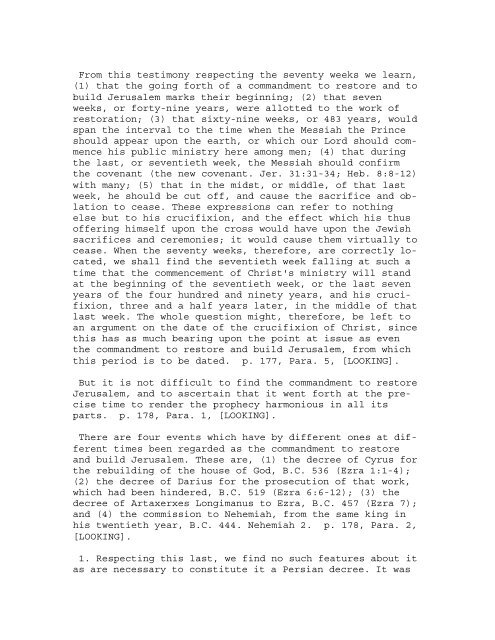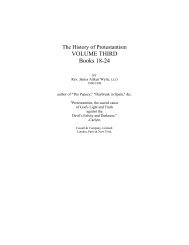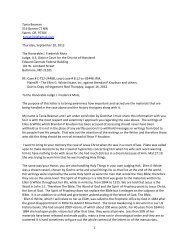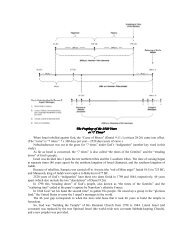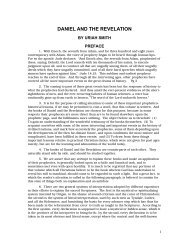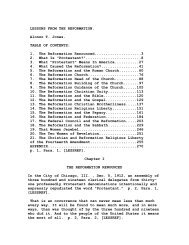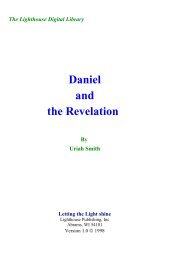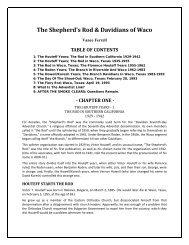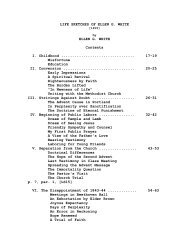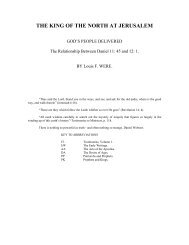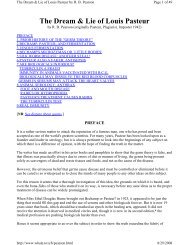LOOKING UNTO JESUS OR CHRIST IN TYPE AND ANTITYPE. BY ...
LOOKING UNTO JESUS OR CHRIST IN TYPE AND ANTITYPE. BY ...
LOOKING UNTO JESUS OR CHRIST IN TYPE AND ANTITYPE. BY ...
Create successful ePaper yourself
Turn your PDF publications into a flip-book with our unique Google optimized e-Paper software.
From this testimony respecting the seventy weeks we learn,<br />
(1) that the going forth of a commandment to restore and to<br />
build Jerusalem marks their beginning; (2) that seven<br />
weeks, or forty-nine years, were allotted to the work of<br />
restoration; (3) that sixty-nine weeks, or 483 years, would<br />
span the interval to the time when the Messiah the Prince<br />
should appear upon the earth, or which our Lord should commence<br />
his public ministry here among men; (4) that during<br />
the last, or seventieth week, the Messiah should confirm<br />
the covenant (the new covenant. Jer. 31:31-34; Heb. 8:8-12)<br />
with many; (5) that in the midst, or middle, of that last<br />
week, he should be cut off, and cause the sacrifice and oblation<br />
to cease. These expressions can refer to nothing<br />
else but to his crucifixion, and the effect which his thus<br />
offering himself upon the cross would have upon the Jewish<br />
sacrifices and ceremonies; it would cause them virtually to<br />
cease. When the seventy weeks, therefore, are correctly located,<br />
we shall find the seventieth week falling at such a<br />
time that the commencement of Christ's ministry will stand<br />
at the beginning of the seventieth week, or the last seven<br />
years of the four hundred and ninety years, and his crucifixion,<br />
three and a half years later, in the middle of that<br />
last week. The whole question might, therefore, be left to<br />
an argument on the date of the crucifixion of Christ, since<br />
this has as much bearing upon the point at issue as even<br />
the commandment to restore and build Jerusalem, from which<br />
this period is to be dated. p. 177, Para. 5, [<strong>LOOK<strong>IN</strong>G</strong>].<br />
But it is not difficult to find the commandment to restore<br />
Jerusalem, and to ascertain that it went forth at the precise<br />
time to render the prophecy harmonious in all its<br />
parts. p. 178, Para. 1, [<strong>LOOK<strong>IN</strong>G</strong>].<br />
There are four events which have by different ones at different<br />
times been regarded as the commandment to restore<br />
and build Jerusalem. These are, (1) the decree of Cyrus for<br />
the rebuilding of the house of God, B.C. 536 (Ezra 1:1-4);<br />
(2) the decree of Darius for the prosecution of that work,<br />
which had been hindered, B.C. 519 (Ezra 6:6-12); (3) the<br />
decree of Artaxerxes Longimanus to Ezra, B.C. 457 (Ezra 7);<br />
and (4) the commission to Nehemiah, from the same king in<br />
his twentieth year, B.C. 444. Nehemiah 2. p. 178, Para. 2,<br />
[<strong>LOOK<strong>IN</strong>G</strong>].<br />
1. Respecting this last, we find no such features about it<br />
as are necessary to constitute it a Persian decree. It was


